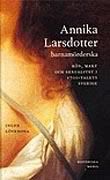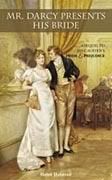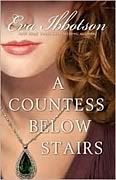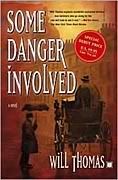|
an archive of my forays into fact and fiction
|
|
Annika Larsdotter: barnamörderska; Inger Lövkrona
— Love @ 13:40 Comments (0)
Filed under: Back to History, C, History, Swedish, To Be Read, True crime
 Annika Larsdotter: barnamörderska Annika Larsdotter: barnamörderska
by Inger Lövkrona

For the Back to History and To Be Read reading challenges.
Swedish
255 pages
Historiska Media
ISBN: 91-88930-64-5
First line: Boston — Min vän slänger tidningsartikeln pÃ¥ skrivbordet med en kort kommentar: “Ja, här har du en till.”
Back cover blurb:
Annika Larsdotter avrättades 1765, 18 år gammal. Hon hade då erkänt dråp på sitt nyfödda barn genom kvävning. Barnets far var Annikas svåger som hade tvingat henne till sexuellt umgänge, men sedan förnekade faderskapet.
Annika Larsdotter var en av tusentals unga svenska kvinnor som under 1600-, 1700- och 1800-talen anklagades för barnamord eller fosterfördrivning. Brottet ansÃ¥gs vara samtidens största samhällsfara. Barnamörderskor dömdes strängt och utan förbarmande — kvinnan beskrevs ofta som en osedlig, ondskefull och grym moder, i nära släktskap med häxor.
Denna bok handlar om Annika men också om några av hennes olyckssystrar. Varför valde dessa kvinnor att mörda sitt barn? Varför valde de inte istället att, i likhet med andra ogifta mödrar, ta på sig rollen som ogift mor?
Etnologen Inger Lövkrona söker svaren genom att studera rättsfall från perioden 1729-1776. De bevarade domstolsprotokollen ger unika möjligheter att komma nära barnamörderskornas handlingar, tänkbara överväganden och känslor.
Very short synopsis in English: This is the study of eight cases from 18th century Sweden where young, unwed women murdered, or were accused of having murdered, their newborn children. Why did they do it?
Thoughts: This was a very interesting read, but what struck me as most shocking was an excerpt at the very beginning of the book, about “prom moms”. It’s easy to read about a case from the 18th century, where shame and desperation led someone to commit almost unspeakable offenses, and think that at least we’ve moved on from that now. Not everywhere we haven’t. Young women still sometimes don’t see any other way out. It’s absolutely horrifying and sad — it was then and it is now.
The book was sometimes a bit tricky to follow, but that always happens to me when I haven’t read academic texts in a while. All things considered, a C grade is in order.
Mr. Darcy Presents His Bride; Helen Halstead
— Love @ 06:57 Comments (4)
Filed under: Back to History, D, English, Historical, Romance
 Mr. Darcy Presents His Bride Mr. Darcy Presents His Bride
by Helen Halstead

For the Back to History reading challenge.
English
310 pages
Ulysses Press
ISBN: 978-1-56975-588-4
First line: What a joy it is to have a worthy topic of conversation, to hold the power to amaze!
Back cover blurb:
In Pride & Prejudice, Jane Austen brought together one of the most beloved literary couples of all time—Elizabeth Bennet and Fitzwilliam Darcy. Now, Mr. Darcy Presents His Bride continues the story of these passion-filled newlyweds as they enter London’s glamorous high society.
This page-turning novel finds Elizabeth and Mr. Darcy entangled in the frivolity and ferocity of social intrigues. Although Elizabeth makes a powerful friend in the Marchioness of Englebury, the rivalry and jealousy among her ladyship’s prestigious clique threatens to destroy the success of her new marriage.
Written in the style of Jane Austen, full of humour and sardonic wit, Mr. Darcy Presents His Bride brings Regency society vividly to life and continues the romantic, sometimes tragic, stories of other popular Pride & Prejudice characters including Georgiana Darcy and Kitty Bennet.
Thoughts: This is the first sequel to Pride & Prejudice that I have ever read (I tend to go for re-workings of the story, rather than continuations of it) and I can’t say I liked it much.
One of the reasons why was that the author felt that she needed to include explanations of who original characters were, and reminders of events of the original novel. It might just be me, but I would think that, if you decide to read a fan-written sequel to a well-known novel, you are probably quite a big fan of said novel already, and would know such basic facts as who Sir William Lucas is, &c.
It wasn’t all bad, though. I quite like Halstead’s take on Miss Anne de Bourgh, for example, and Lord Maddersfield (that’d be Lady Catherine’s brother and Darcy’s uncle) was quite amusing.
On the whole, though, it was not the best of reading experiences. I might add to this later (I have seven minutes before I have to leave for work), but for now, I shall leave it at this and give this work of fiction a D rating.
Standish; Erastes
— Love @ 13:38 Comments (2)
Filed under: Back to History, D, English, GLBT interest, Historical, Romance
 Standish Standish
by Erastes

For the Back to History reading challenge.
English
215 pages
P.D. Publishing Inc.
ISBN: 1-933720-09-3
First line: The candle guttered, and Ambrose looked up at it with a frown, the long blond hair falling away from the sides of his face.
Back cover blurb:
A great house. A family dispossessed. A sensitive young man. A powerful landowner. An epic love that springs up between two men. Set in the post-Napoleonic years of the 1820’s, Standish is a tale of two men — one man discovering his sexuality and the other struggling to overcome his traumatic past.
Ambrose Standish, a studious and fragile young man, has dreams of regaining the great house his grandfather lost in a card game. When Rafe Goshawk returns from the continent to claim the estate, their meeting sets them on a path of desire and betrayal which threatens to tear both of their worlds apart.
Painting a picture of homosexuality in Georgian England, Standish is a love story of how the decisions of two men affect their journey through Europe and through life.
Thoughts: From the moment I came across this book on Amazon.co.uk, I knew I had to read it. The story sounded amazing and I just love historical gay romance, there’s no denying that. Unfortunately, I was in for quite a disappointment.
I started reading it in January, got about a third of the way through during my first sitting with it, and then I put it down and did not pick it up again until now. I kept trying to persuade myself that if I read only one chapter a day, I would finish it in less than a month, but there just was no way of doing it. I wanted so badly to love the story, and I just couldn’t do it. I had such a hard time with the language and the way it was written — they didn’t appeal to me at all.
Finally, I picked it up again and found that if I just skimmed certain bits, it was tolerable. And so I finished the remaining two-thirds in a second sitting. I even, towards the end, found myself almost enjoying it. A part of the reason for this was, I dare say, the character of Padraig Fleury who appeared in the second half of the novel.
In the end, I didn’t like it even half as much as I had hoped to going in, but on the other hand, I did like it more than I thought I would after the first third. Even though it’s nowhere near the best book I’ve ever read, I am glad I decided to stick with it and read the entire thing. I have rarely been so close to making a book a DNF (did not finish), though. If it weren’t for the fact that I had it on my (no changes allowed) list of books for the Back to History challenge, or the fact that I had paid money for it and didn’t much like the idea of that being wasted, I don’t think I would have finished.
However, apart from all that I have outlined above, there was another thing that particularly bothered me. At one point Ambrose reads Dracula. Which is, y’know, cool and all. Except Standish is set in 1821 and Dracula wasn’t published until 1897, so unless there was time travel that I completely missed, that’s a big mistake on the part of the author, and that loses them a lot of respect from me.
I should think it obvious that the rating is not going to be a great one, but in the end, solely thanks to Fleury, it does manage a D, rather than an F. I realise we are only at the end of February and that much of the reading year remains, but I will be much surprised if this does not end up being “Disappointment of the Year.â€
A Countess Below Stairs; Eva Ibbotson
— Love @ 18:23 Comments (5)
Filed under: A, A-Z Reading Challenge, Back to History, English, Historical, Romance
 A Countess Below Stairs A Countess Below Stairs
by Eva Ibbotson

For the Back to History and A-Z reading challenges.
English
383 pages
Speak
ISBN: 978-0-14-240865-0
First line: In the fabled, glittering world that was St. Petersburg before the First World War there lived, in an ice-blue palace overlooking the river Neva, a family on whom the gods seemed to have lavished their gifts with an almost comical abundance.
Back cover blurb:
After the Russian Revolution turns her world topsy-turvy, Anna, a young Russian countess, has no choice but to flee to England. Penniless, Anna hides her aristocratic background and takes a job as a servant in the household of the esteemed Westerholme family, armed only with an outdated housekeeping manual and sheer determination.
Desperate to keep her past a secret, Anna is nearly over-whelmed by her new duties—not to mention her instant attraction to Rupert, the handsome Earl of Westerholme. To make matters worse, Rupert appears to be falling for her as well. As their attraction grows stronger, Anna finds it more and more difficult to keep her most dearly held secrets from unraveling. And then there’s the small matter of Rupert’s beautiful and nasty fiancée…
Thoughts: This is, without a doubt, one of my favourite books. I think it might even trump Pride and Prejudice as the one. I first read it in ninth grade when I found it, quite by accident, in the library at school. I was familiar with Ibbotson’s other body of work, those fantastical books of hers aimed at children, but I didn’t know she also wrote for another audience. At first, I admit I was a little doubtful—it was a romance, after all, and the translation was rather sloppily done (the original title was written as “A Countness Below Stairs”, that’s how sloppy it was), and the cover didn’t look like much. But oh god, I was blown away! I overlooked the typos and the printing errors, and just devoured the book. When I put it down, my eyes were wet from tears (I can be an übersap, sometimes) and it was late at night. The next day, when I came home from school, I picked it back up and read it all over again.
Since then, I’ve read it over and over again, always still in the same sloppy translation, but now I’ve finally found it in the original and thus it was almost like discovering it all over again. I can now tell that while the publishing work of the translation left quite a bit to be desired, the actual translation wasn’t half-bad. I know it so well now that reading the original, I was a little astounded that the errors I had grown so used to weren’t there. But oh, how I still love it! And still, this the sixth (or seventh? I’ve lost count) time I read it, I was still moved to tears in the exact same places, even though I know how it all ends.
As you know, I don’t usually post quotes, but sometimes I simply have to make an exception. Lord Peter Wimsey books often produce such exceptions, and so does A Countess Below Stairs.
“Rupert, none of your servants are socialists, I hope?”
“Good heavens no, I shouldn’t think so. I mean, I haven’t asked. Surely you don’t have to be a socialist to want to have a bath?”
“It often goes together,” said Muriel sagely.
And so they played some of the world’s loveliest piano music—the exiled homesick girl, the humiliated, tired old man. Not properly. Better than that.
Torn between despair and embarrassment, between loneliness and shame, the earl’s dog stood before them, his great head raking the room. He had done it, the unspeakable thing. The degradation, the horror of it, was behind him—and now where was she? Had it all been in vain; the debasement, the agony, the choice?
But no, it was all right. He’d seen her. She was there. She would make whole what was broken, console him for his master’s absence, would understand his imperative need to be scratched now, this minute, and for a long time in that special place behind his ear.
It’s seems a bit like stating the too obvious at this point, but the rating I’m giving this book is a solid A. There’s no other alternative — trust me on this. What’s a bit funny, though, is that I’m not head over heels for any of the characters, nor really the writing either, which is usually the case for me. I just completely and utterly love the whole book.
To end this post, I’m going to post the link to a music video on YouTube. The song is I Saved the World Today by The Eurythmics and no, there’s no apparent connection. But when I first read A Countess Below Stairs, the single had just been released and was being played on the radio as I read the book, and so the two will always, for me, be interconnected.
Some Danger Involved; Will Thomas
— Love @ 19:56 Comments (1)
Filed under: A-Z Reading Challenge, B, Back to History, English, Historical, Mystery
 Some Danger Involved Some Danger Involved
by Will Thomas

For the Back to History and A-Z reading challenges.
English
302 pages
Touchstone
ISBN: 978-0-7432-5619-3
First line: If someone had told me, those many years ago, that I would spend the bulk of my life as assistant and eventual partner to one of the most eminent detectives in London, I would have thought him a raving lunatic.
Back cover blurb:
An atmospheric debut novel set on the gritty streets of Victorian London, Some Danger Involved introduces detective Cyrus Barker and his assistant, Thomas Llewelyn, as they work to solve the gruesome murder of a young scholar in London’s Jewish ghetto. When the eccentric and enigmatic Barker takes the case, he must hire an assistant, and out of all who answer an ad for a position with “some danger involved,” he chooses downtrodden Llewelyn, a gutsy young man with a murky past.
As they inch ever closer to the shocking truth behind the murder, Llewelyn is drawn deeper and deeper into Barker’s peculiar world of vigilante detective work, as well as the heart of London’s teeming underworld.
Thoughts: Sometimes, when you read the first line of a book, you just know that you’re going to end up loving the whole book. This one had one of those and I was not disappointed in the least. It reads very much like a classic Holmes-type detective story, but is in fact written just a few years ago.
And oh, Victorian London! It’s one of my favourite settings for books, I have to admit. All that grime and slum and, well, everything about it — I adore it. As for the story line itself, it was pretty good. It wasn’t obvious whodunnit, but there were a couple of clues that you could’ve picked up on (unless you’re as dense as me, of course), which is nice. I don’t like mysteries where the solution is too obvious, but neither do I like when it’s so surprising you still can’t see the clues even when you know the answer.
This was the first in a series and although I like it, I’m not sure I’ll read the following books. At least I’m not absolutely dying to.
For the moment, rest assured that the B grade I’m giving it is very well-deserved.
|
|
 Annika Larsdotter: barnamörderska
Annika Larsdotter: barnamörderska

 Mr. Darcy Presents His Bride
Mr. Darcy Presents His Bride
 Standish
Standish
 A Countess Below Stairs
A Countess Below Stairs Some Danger Involved
Some Danger Involved